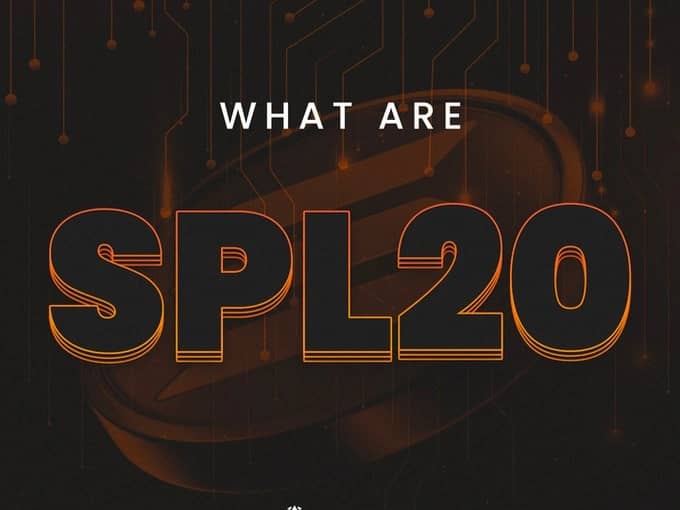위키 구독하기
Share wiki
Bookmark
SPL-20 (Solana Program Library-20)
SPL-20 (Solana Program Library-20)
**SPL-20 (Solana Program Library-20)**는 솔라나 블록체인에서 토큰을 생성하고 관리하기 위한 표준입니다. 이더리움의 ERC-20 표준과 마찬가지로, SPL-20은 대체 가능 토큰과 대체 불가능 토큰(NFT) 모두를 위한 규칙 및 인터페이스를 포함하는 포괄적인 프레임워크를 구축합니다. 일반 통화와 같은 대체 가능 토큰은 서로 바꿔 사용할 수 있으며 정량화 가능한 가치를 나타내는 반면, 대체 불가능 토큰은 각각 고유한 특성과 가치를 지닌 독특한 디지털 자산입니다.[1]
역사
SPL-20 토큰 표준은 대체 가능 토큰의 생성 및 관리를 간소화하기 위해 도입되었습니다. 2017년 아나톨리 야코벤코에 의해 설립된 솔라나는 2020년 3월에 고도로 확장 가능하고 효율적인 블록체인 플랫폼을 제공하기 위해 출시되었습니다. 개발자들이 대체 가능 토큰이 필요한 분산형 애플리케이션(dApp)을 구축하기 시작하면서 솔라나 팀은 SPL-20을 포함하는 솔라나 프로그램 라이브러리(SPL)를 만들었습니다.
이더리움의 ERC-20 표준에서 영감을 받은 SPL-20은 토큰 개발을 위한 통일된 규칙과 기능을 제공하여 솔라나 생태계 내의 상호 운용성을 보장하도록 설계되었습니다. 이 표준에는 토큰 발행, 소각 및 이전과 같은 필수 기능이 포함되어 다양한 dApp과의 원활한 통합을 용이하게 합니다.
도입 이후 SPL-20은 탈중앙화 금융(DeFi), 디지털 통화 및 자산 토큰화에서 다양한 애플리케이션을 지원하는 솔라나의 기반이 되었습니다. 솔라나의 높은 트랜잭션 속도와 낮은 수수료로 인해 개발자와 사용자 모두에게 선호되는 선택이 되었습니다. 솔라나가 계속 성장함에 따라 SPL-20 표준은 블록체인 분야의 지속적인 혁신과 개발을 지원하는 데 중요한 역할을 합니다.[2]
개요
SPL-20 토큰은 솔라나 블록체인에서 작동하는 디지털 자산입니다. SPL-20 표준은 이러한 토큰에 대한 규칙을 설정하여 솔라나 지갑 및 스마트 계약과의 호환성을 보장합니다. 블록체인의 핵심 운영 및 합의 메커니즘에 필수적인 솔라나의 네이티브 코인과 달리 SPL-20 토큰은 별도로 작동합니다. 다른 암호화폐처럼 사용할 수 있지만 솔라나의 네이티브 코인으로 거래 수수료를 지불해야 합니다.[3]
흥미롭게도 솔라나의 네이티브 코인은 SPL 표준을 준수하기 때문에 SPL 토큰으로 간주되지만, 네트워크 출시 이후부터 핵심적인 역할을 해왔기 때문에 고유합니다. SPL-20 표준은 이더리움의 ERC-20과 마찬가지로 솔라나 블록체인에서 대체 가능 토큰과 대체 불가능 토큰을 생성하고 관리하기 위한 지침을 제공합니다. 대체 가능 토큰은 서로 바꿔 사용할 수 있으며 통화처럼 작동하는 반면, 대체 불가능 토큰(NFT)는 고유한 디지털 자산입니다.
SPL-20 비문은 비트코인의 BRC-20 표준과 유사하게 디지털 아트의 온체인 저장을 허용합니다. 이러한 고유한 솔라나 주소에는 블록체인에 직접 저장된 이미지가 포함될 수 있어 NFT 생성을 용이하게 합니다.[4]
솔라나 블록체인 및 호환되는 가상 머신용으로 설계된 SPL-20 표준은 토큰을 생성, 관리 및 전송하는 방법을 설명합니다. 여기에는 작동 매개변수를 정의하고 네트워크 생태계 내에서의 기능을 보장하는 것이 포함됩니다. SPL-20 토큰은 팬텀과 같은 솔라나 전용 지갑을 통해 관리됩니다. 일부 지갑은 여러 블록체인을 지원하지만 이더리움 또는 솔라나에 맞춰 제작된 지갑은 반대편 네트워크의 토큰을 지원하지 않습니다. 즉, MetaMask 지갑을 사용하여 솔라나 토큰을 거래할 수 없으며(솔라나 지갑 MetaMask Snap을 통해서는 가능), ERC-20 토큰은 팬텀과 같은 솔라나 지갑에 저장할 수 없습니다.[5]
SPL-20의 특성
- 속도 및 효율성: SPL-20 토큰은 솔라나의 고속 블록체인을 활용하여 다른 많은 네트워크에 비해 더 빠르고 확장 가능한 거래를 더 낮은 수수료로 가능하게 합니다.
- 광범위한 애플리케이션: 게임부터 금융까지 SPL-20 토큰은 다양한 분야의 프로젝트를 지원하는 다용도입니다. 솔라나 생태계에서 NFT, DeFi 플랫폼 등을 확장하는 데 중요한 역할을 합니다.
- SPL 표준은 솔라나 블록체인에서 대체 가능 토큰과 대체 불가능 토큰 모두에 대한 운영 지침을 설명합니다. 서로 다른 토큰 유형에 대해 별도의 표준을 가지고 있는 이더리움과 달리 솔라나의 SPL 표준은 두 유형 모두에 보편적으로 적용됩니다. SPL에서 대체 가능 토큰과 대체 불가능 토큰의 주요 차이점은 발행된 토큰 수, 분할 가능성 및 추가 속성과 같은 요소를 기반으로 토큰 생성 시 결정됩니다.
- 구성 가능성: SPL 토큰의 소스 코드를 재사용하여 다른 SPL 토큰을 만들 수 있습니다. 이를 통해 개발자가 새로운 토큰을 더 쉽게 만들 수 있습니다. 생성자의 의도에 따라 토큰 이름 및 공급 통계와 같은 몇 가지 기능은 생성 시점에 변경될 수 있지만, 대부분의 코드베이스는 수정 없이 배포되어도 예상된 결과를 제공할 수 있습니다.[6]
잘못된 내용이 있나요?
